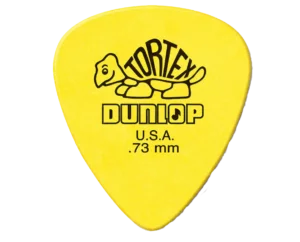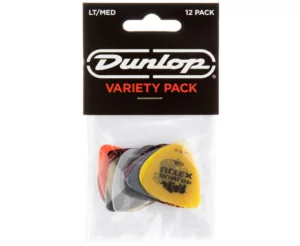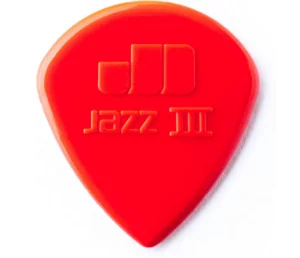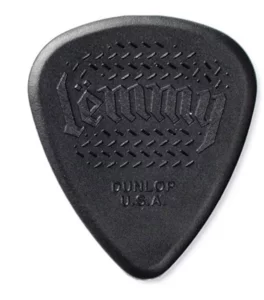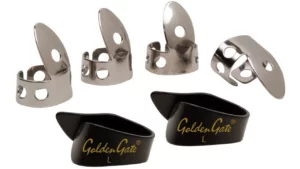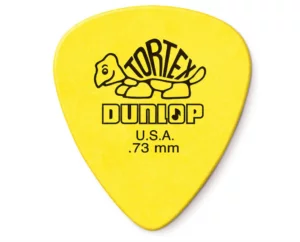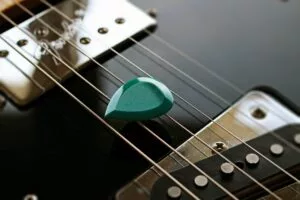
The Best Guitar Picks in Canada
For any guitar player, the guitar pick is an essential tool. After all, the pick (combined with the guitar strings) is what generates the sound from the guitar. There are plenty of guitar picks on the market, and they come in all shapes, sizes, and colours. With so many options, it can be difficult deciding which one to pick (no pun intended). That’s why we created this buying guide to list the best guitar picks in Canada.
Our top picks
What to look for in a guitar pick
Thickness: Guitar picks come in different thicknesses, also known as gauges. Here are the five main gauges for guitar picks:
- Extra Thin: 0.45mm and lower
- Thin: 0.46mm-0.70mm
- Medium: 0.71-0.84mm
- Thick: 0.85mm-1.20mm
- Extra Thick: 1.20mm and above
Each thickness influences your playing style and the tones you will get. Extra thin and thin picks are best for acoustic guitars and rhythm playing (e.g. strumming chords). They create a bright sound. Medium guitar picks are good for acoustic and electric guitars. They are compatible with most playing styles, and they produce a balanced tone. Thick and extra thick guitar picks are best for electric guitars. They create a mellow, deep tone and are best for fast picking.
When it comes to guitar thickness it is all a matter of personal preference. We recommend you experiment with different gauges to see which one works for you.
Material: In the past, guitar picks were made from a material called tortoise shell, which was the outer shell of an Atlantic hawksbill sea turtle. Obviously, this practice was harmful to the turtle population. Eventually, manufacturers stopped using tortoise shell to make guitar picks. Currently, picks are made from plastic, metals like aluminum, celluloid, nylon, xylonite, and Dupont Delrin.
In reality, there is no best material for guitar picks; it comes down to personal preference. However, there are some things to consider. First, some materials are more durable than others. For example, nylon picks tend to last longer than celluloid picks. The second consideration is the feel of the pick. Some picks have a smooth feel, while others have a grip-like texture. Lastly, different materials will produce different tones. For example, nylon picks have a distinct tone that is bright and warm while celluloid picks have a balanced, rich sound.
Size and Shape: Most guitar picks have the classic pear drop shape. There are other unique shapes like shark fin, round, and triangle. Whichever shape you chose, the sound you will get is determined by the sharpness of the pick (i.e., the part the hits the strings). Picks with sharp points have a strong attack and produce a bright tone. They work best for soloing. Picks with round points have a softer attack and a mellower tone. They work best for strumming.
The size of the guitar pick depends on the size of your hand. What is small to one person may be large to you. One thing to note is that smaller guitar picks create less distance between your hands and the strings. This makes it easier to use hand techniques like palm muting or finger picking.
As with the previous category, the shape and size of the guitar pick you use is up to you. Go with the one that you feel comfortable with.
Some Terminology:
Release: How fast a pick returns to its shape after it hits the guitar’s strings.
Memory: How long a pick holds it shape over time and usage.
Best guitar pick overall
Dunlop Tortex Standard
The Dunlop Tortex Standard is a popular choice with players. This is a versatile pick in many aspects. The Tortex Standard creates a balanced tone that is both bright and deep. It can be used for electric and acoustic guitars, and it is compatible with most playing styles. With the Tortex Standard, you can strum simple chords, or you can fire off a fast guitar solo.
Because of its versatility, the Dunlop Tortex Standard is a great guitar pick for beginners as well as veteran players. Overall, many customers felt that the Tortex Standard was a well-rounded guitar pick. It had a natural grip, was durable, and produced a great sounding tone.
Pros
- Versatile.
- Good for both beginner and experienced players.
Cons
- N/A.
Best guitar pick for beginners
Jim Dunlop Variety Pack
This package from Jim Dunlop contains 12 guitar picks that are light to medium in thickness (.58mm-.71mm). The picks included are the Nylon Standard, Nylon Max Grip, Tortex Standards, Ultex, Gator Grip, and the Thin and Medium Celluloid picks. With this large sample of guitar picks, you can try out each one to see which works for you. This is the main reason why this package is perfect for beginner players; they get to experiment with various thicknesses and textures.
Many customers liked the value of this variety pack from Jim Dunlop. Some people said that this variety pack helped them find their favourite pick. The only downside is that this variety pack does not include any thick guitar picks. If these were included, then this Jim Dunlop variety pack would be the perfect guitar pick starter kit for beginner players.
Pros
- Variety of guitar pick to try.
Cons
- No thick guitar picks.
Best custom guitar pick
Clayton Custom Picks
If you want to add your own personal touch to a guitar pick, then Clayton Custom Picks are the right ones for you. There are several steps to design your pick with Clayton.
- Select a pick material: Clayton offers several materials to choose form, such as Delrin, metal, carbonate, and white pearl.
- Pick options: After you have selected your pick material, the next step is to choose from several options. The first one is pick thickness (either .50, .71, 1.0, 0r 1.26mm). Next, choose whether your pick design will be printed one or both sides, whether you want one colour or full colour printing, and if you want your image to go the edge of the guitar pick. Lastly, choose the pick’s shape; either the traditional style or the triangular shape.
- Design the pick: Once you have made your selections, you can go about designing your pick. You can add images or texts to the pick, and you can change the font colour.
- Order: After you have finished designing the pick, you can select how many you want to order. The picks come in packages of 100, 200, 400, 600, 800, or 1000. Pricing depends on your design selections. If you chose to have a two sided or full-colour pick, then the price will be higher.
There are many positive testimonials from customers on Clayton Custom Picks. One customer called the picks “first rate, top quality, perfect in every detail”. Others found the design process seamless and the picks to be high quality. There are only two minor complaints with the Clayton Custom Picks. First, there are a limited number of fonts to choose from. Second, depending on your design options, these picks can be expensive. Still, Clayton Custom Picks are a great product for guitar players.
Pros
- Plenty of design options.
- Easy process.
Cons
- Limited number of fonts.
- Depending on design options, price can get expensive.
Best guitar pick for thrash metal/shredding
Jim Dunlop Jazz
Players who are into thrash metal need a pick that lets them hammer out riffs or solos at blindingly fast speeds. The Jim Dunlop Jazz III is the guitar pick to meet those needs of thrash metal players. The pick has a quick release molded edge and a sharp tip for better articulation. The pick’s material gives you more control, which lets you play with speed and precision. The Jim Dunlop Jazz III comes in two colour options, which affects the tone you get. The red nylon version creates a warm sound, while the black “stiffo” version has a more aggressive and bright tone.
Many people thought that the Jazz III had excellent articulation, making it great for fast paced precision picking. As one customer put it, the Jazz III is “the fastest pick in the West”. Because of its articulation, several people recommended the Jazz III to anyone wanting to play thrash metal. One thing to note is that this pick is much smaller than the standard guitar pick. This might take some time to get used to. But once you have adapted to the Jazz III’s small size, you may prefer it over regular sized picks.
Pros
- Good for fast precision picking.
Cons
- Smaller than regular picks, which can take some getting use to.
Best pick for acoustic guitar
BlueChip TAD-50
The TAD-50 from BlueChip is a specially designed guitar pick for acoustic guitar. It is made from high grade, self-lubricating composite material. This not only makes it durable, but it also makes it fast. Even though most player use thinner picks for acoustic guitar, the TAD-50 is 1.25mm thick. This high gauge makes the TAD 50 ideal for lead playing, put it also works well for rhythm playing.
Overall, the BlueChip TAD-50 was quite popular with guitar players. Many highlighted the pick’s balanced tone, which was described as “warm, smooth, tight, and punchy”. Customers praised the TAD-50’s playability, with several saying they could feel the pick seamlessly slide off the strings. Because of this playability and feel of this pick, some customers said that they could not go back to regular guitar picks. They only downside to the TAD-50 is that it is expensive compared to other guitar picks. The cost for one TAD-50 is $35.00, not including shipping or handling.
Pros
- Easy to hold and play.
- Creates a balanced tone.
Cons
- Expensive.
Best pick for bass guitar
Dunlop Motorhead Lemmy Signature Guitar Pick
Lemmy Kilmister was the bass player, singer, and leader of the influential heavy metal band Motorhead. Kilmister was known for his trademark gruff voice and aggressive playing style. Unfortunately, the music world lost Lemmy in 2015. To honour the legendary musician, Jim Dunlop issued a special series of guitar picks.
The Lemmy Signature guitar picks are the actual ones Kilmister used throughout his career. They are 1.14mm thick, making it ideal for thick bass strings and an aggressive playing style. These picks are made from nylon, which provides a non-slip grip. Lastly, a metal tin to store picks is included.
Customers said that the Lemmy Signature guitar pick gave a loud and clear sound. People also said that you can play both soft and aggressive music with this pick. In the end, people enjoyed the Lemmy Signature guitar picks, with several saying they were a fitting tribute to the metal legend.
Pros
- Compatible with several musical genres.
- Has good grip.
Cons
- N/A.
Best banjo pick
National Thumb and Finger Pick
Instead of the traditional flat pick, banjo players use finger picks. The thumb and finger picks from National are good for banjo playing, but you can also use them to play other string instrument. These picks are designed to be long lasting. The four finger picks are made from stainless steel while the two thumb picks are made from ABS plastic. For improved comfort, the picks are adjustable and ergonomically designed.
Several people said that these picks made learning the banjo easy. Most found that the picks were comfortable and were easy to adjust. The sound these National picks make was another positive among customers. People described the tone as warm and vibrant. There were no major complaints about the National Thumb and Finger picks. However, if you are new to finger picks, then there is a learning curve to using them. You will need plenty of practice with them, so patience is needed. But this factor does not take away from the quality of the National Thumb and Finger Picks.
Pros
- Comfortable fit.
- Creates a warm and vibrant sound.
Cons
- N/A.
Our methodology
For this buying guide, we spent over eight hours researching various guitar picks. We only considered picks rated four or more stars. To help us make our selections, our team read many customer reviews. These reviews helped us learn what people want out of a good guitar pick. Whenever we needed additional information, we referenced trusted websites. Lastly, we based or selections on the playability of the guitar pick.
Frequently asked guitar pick questions
What are they types of guitar picks?
Guitar pick types are dependent on the material, thickness, and design of the pick. These three factors can be combined in a number of ways to create a guitar pick. For example, you can have a thin nylon pick, or an extra thick triangular pick made from stainless steel. Therefore, there are no set guitar pick types, there is just too much variety.
How do you properly hold a pick?
Traditionally, a guitar pick is held by your pointer finger, middle finger, and thumb. The thumb is placed on the front of the pick, while the pointer and middle fingers are on the pack of the pick. Some people only use their pointer finger and thumb to hold the pick.

How to hold a guitar pick. Source: Music To Your Home
How do I use a pick on a guitar?
Position your hand near or at the bridge of the guitar. If you are playing an acoustic guitar, position your hand close to the sound hole. That way, you will get the best tones possible. If you are strumming, then move your wrist up and down. If you are picking individual strings, then lightly move your wrist down.
As you gain more experience, you can develop different playing techniques. For example, you can learn to sweep pick or use the pick to create pinch harmonics. The one thing to remember is to keep your arm and wrist relaxed as you play. This will give you the best playing style possible. If your arm and wrist are tense, then you will make more mistakes.
What is a plectrum?
A plectrum is another word for a guitar pick. It is mostly used in Europe.
How do I play a guitar without a pick?
There are plenty of ways to play a guitar without a pick. The first way is to use your fingers. This style is difficult as you must be more precise. Also, your fingers can develop callouses if you play for a long time. Besides your fingers, you can use any object that resembles a pick. Some players use coins, the most famous being Brian May of Queen. Bread tags are another popular alternative to guitar picks.
Where can I buy guitar picks?
You can buy guitar picks at any music store. You can also buy picks online at Amazon or from guitar pick manufacturers like Fender, Gibson, Jim Dunlop, and D’addario.
Read more

The Best Guitar Strings in Canada
Guitar strings are integral to how a guitar sounds and plays. Choose the best strings for your axe here.

The Best Karaoke Software
Party like it’s 1999 with karaoke!

Tabletop Gaming: An Introduction
More than just D&G! Tabletop RPGs are a great way to spend time with friends away from the screens.

The Best Acoustic Guitars At Any Price
Playing music is a fun and rewarding hobby. This buying guide lists the best acoustic guitars available.
